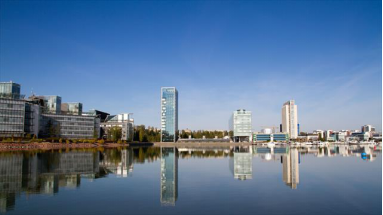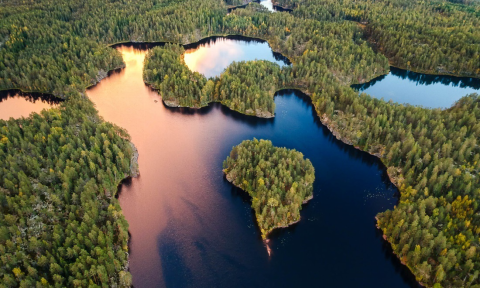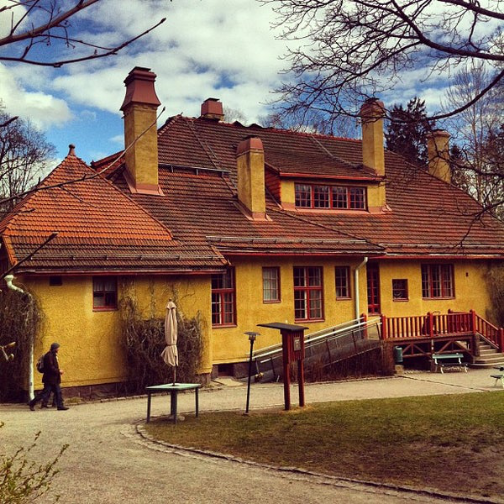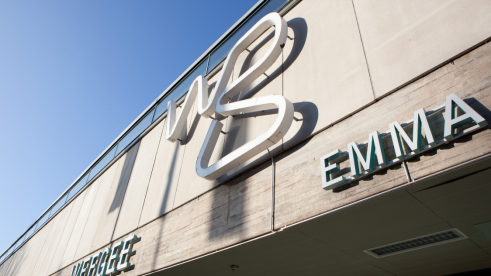Espoo,Finland 作者: 来源: 发布时间:2021-02-08
一、所属省或是州,具体位置,人口,面积

Espoo is the second largest city and municipality in Finland. It is part of the Finnish Capital Region, along with the cities of Helsinki, Vantaa, and Kauniainen, and most of its population lives in the inner urban core of the Helsinki metropolitan area. Espoo shares its eastern border with Helsinki and Vantaa, while enclosing Kauniainen. Other bordering municipalities of Espoo are Nurmijärvi and Vihti in the north, and Kirkkonummi in the west. The city is located on the shore of the Gulf of Finland, in the region of Uusimaa, and has a population of 284,444.
Espoo does not have a traditional city center, having instead several local regional centers. Espoo is thus divided into seven major areas (Finnish: suuralueet, Swedish: storområden): Vanha-Espoo (with administrative center), Suur-Espoonlahti, Pohjois-Espoo, Suur-Kauklahti, Suur-Leppävaara, Suur-Matinkylä, and Suur-Tapiola.
Aalto University is based in Otaniemi, Espoo, along with a thriving science community that includes numerous startups and organizations such as VTT – the Technical Research Center of Finland. Several major companies are based in Espoo, including Nokia, HMD Global, Tieto, KONE, Neste, Fortum, Orion Corporation, Outokumpu, and Foreca, as well as video game developers Rovio and Remedy Entertainment.
The city of Espoo is officially bilingual. The majority of the population, 83.6%, speaks Finnish as their mother tongue, while a minority of 8.3% speaks Swedish. 8% of Espoo's population has a first language other than Finnish or Swedish.
二、自然地理
1.地理条件
Espoo is located in southern Finland, along the shore of the Gulf of Finland, and in the region of Uusimaa and the Helsinki sub-region. Prior to the abolition of Finnish provinces in 2009, Espoo was a part of the Southern Finland Province. Espoo encompasses 528 square kilometres (204 sq mi), of which 312 km2 (120 sq mi) is land. The national park of Nuuksio is situated in northwestern Espoo.
The city borders Helsinki, the Finnish capital, which is to the east. Other neighbouring municipalities are Vantaa to the east and northeast, Nurmijärvi to the north, Vihti to the northwest, and Kirkkonummi to the west and southwest. Espoo is a part of the Finnish Capital Region, which is the inner core of the Greater Helsinki metropolitan area.
Although Espoo is relatively highly populated, it has large amounts of natural wilderness, particularly in the city's western and northern portions. The city has a total of 71 lakes, the largest of which are Lake Bodom, Nuuksion Pitkäjärvi, Vanhankylän Pitkäjärvi, Loojärvi, Velskolan Pitkäjärvi, Saarijärvi, Matalajärvi, Siikajärvi, and Lippajärvi. The city has a large coastline on the Gulf of Finland.
Espoo has six Natura 2000protected areas: Bånberget forests, Espoonlahti Saunalahti bay area (partially in Kirkkonummi), Laajalahti bay, Matalajärvi lake, Nuuksio National Park (partially in Kirkkonummi and Vihti), as well as forests in Vestra (partially in Vantaa).
2. 交通情况
Espoo is well-served by public transport, through the Helsinki commuter rail network, the Helsinki Metro's Länsimetro extension opened in November 2017, and buses provided by Helsinginseudunliikenne. In 2024 the orbital Jokeri light rail line will connect Espoo to eastern Helsinki.
三、经济发展和规模
In comparison to other cities the age structure of Espoo is very young. Population growth has been extraordinarily high, foremost due to a constantly high birth surplus. The Municipal tax in Espoo is 18%.The share of population with migration background belongs to the smallest ones and segregation is still rather low. Espoo stands out particularly as family city. Air pollution is below the comparison group’s average. Health and security are considerably better. The share of households living in houses is on average level, whereas the homeownership rate is high. The income state of Espoo includes operating revenue at 380 Million Euros, 1340 Euros per resident.
The proportion of residents qualified at university level is highest in Espoo and the city’s employment rate is on a high level. Full-time employment is most common in Espoo and women’s share of full-time employments is largest. On the other hand the proportion of the self-employed one of the lowest. Espoo’s estimated gross domestic product per capita is the third highest. The city has a strong industrial sector and a relatively large share of jobs in financial intermediation and business activities.
四、产业特点重点项目
The main economic composition includes: corporate group services, technical and environment services, education and cultural services and social and health services and corporate group administration. Innovative products and services in circular economy support the development of Espoo and, in particular, the new Kera district into a sustainable urban environment of the future. “In line with the Espoo Story, the Kera district is being developed as an international example area for circular economy, whose solutions are intertwined with a digital city platform.
The 6Aika project KIEPPI was launched in Espoo to promote circular economy and business-driven circular economy services. KIEPPI, short for Kestävienkaupunginosienkumppanuusmalli (Partnership model for sustainable neighbourhoods), is a project in which Tampere, Espoo and Turku develop new circular and sharing economy solutions for the urban environment.
The project is part of the Sustainable Espoo development programme, which carries through the Espoo Story and aims to promote a carbon-neutral lifestyle in the city. The KIEPPI project is funded by the European Regional Development Fund (ERDF), Uusimaa Regional Council, City of Espoo and other partner cities.
五、风景名胜,景点
1. Nuuksio National Park

Nuuksio National Park, covering a total area of 55 km2 is located in Uusimaa region and it's divided in the areas of Espoo, Kirkkonummi and Vihti. Park's location in the between of the oak forest zone and the southern boreal forest zone makes the nature very versatile and unique. In Nuuksio you can enjoy the variety of landscapes formed by Ice Age.
Over 80 small lakes and ponds are found from Nuuksio National Park and they are as diverse as the nature around them. Some with rocky shores and some surrounded by open bogs.
2. Nature House Villa Elfvik

Nature House Villa Elfvik is the City of Espoo environmental education centre. The Nature House promotes a sustainable lifestyle by offering its visitors ideas on how to behave in a more sustainable manner. Sustainable practices are also demonstrated in the everyday activities of the Nature House. We wish you warmly welcome to the Nature House!The Nature House serves as a Nature school for schools in Espoo. Classes can come for a whole day and make field studies. It also gives further environmental education by offering training courses for teachers and day care staff.
3. WeeGee's Museums

The WeeGee Exhibition Centre consists of four museums: EMMA – Espoo Museum of Modern Art, KAMU – Espoo City Museum, the Finnish Toy Museum Hevosenkenkä and the Finnish Museum of Horology. Located in Tapiola, Espoo, the exhibition centre offers experiences to visitors of all ages. In addition to exhibitions, the museums offer guided tours, workshops and various themed events. WeeGee’s lobby, meeting and restaurant spaces are rented out for meetings and festive occasions.
六、历史文化
1. 历史
The first inhabitants in the area arrived about 9,000 years ago. Physical evidence (pollen grains) indicates agriculture from ca. 1000 AD, but there are no historical records. Up to the 13th century, the area was a borderland between the hunting grounds of Finnish Proper and Tavastian Finns, with a sparse population. Immigrants from Sweden established permanent agricultural settlements to the area from the late 13th century onwards after the so-called Second Crusade to Finland. Espoo was a subdivision of the Kirkkonummi congregation until 1486–1487. The oldest known document referring to Kirkkonummi is from 1330; Espoo as a subchapter has been dated to the 1380s, although the first document directly referring to Espoo is from as late as 1431. The construction of the Espoo Cathedral, the oldest preserved building in Espoo, marks the independence of Espoo. Administratively, Espoo was a part of Uusimaa. When the province was split to Eastern and Western provinces governed from the Porvoo and Raasepori castles, respectively, the eastern border of the Raasepori province was in Espoo. The 13th-century road connecting the most important cities in Finland at that time, the King's Road, passes through Espoo on its way from Stockholm via Turku and Porvoo to Viipuri.
In 1557, King Gustav Vasa decided to stabilize and develop the region by founding a royal mansion in Espoo. The government bought the villages of Espåby and Mankby (Finnish: Mankki) and transferred the population elsewhere, and built the royal mansion in Espåby. (Mankby was eventually abandoned and was never repopulated.) The royal mansion housed the king's local plenipotentiary (vogt), and collected royal tax in kind paid by labor on the mansion's farm. The administrative center Espoonkeskus has grown around the church and the Espoo railway station, but the municipality has retained a network-like structure to the modern day.
In 1920, Espoo was only a rural municipality of about 9,000 inhabitants, of whom 70% were Swedish speaking. Agriculture was the primary source of income, with 75% of the population making their living from farming. Kauniainen was separated from Espoo in 1920, and it gained city rights the same year as Espoo, in 1972.
Espoo started to grow rapidly in the 1940s and '50s. It quickly developed from a rural municipality into a fully-fledged industrial city, gaining city rights in 1972. Due to its proximity to Helsinki, Espoo soon became popular amongst people working in the capital. In the fifty years from 1950 to 2000, the population of Espoo grew from 22,000 to 210,000. Since 1945, the majority of people in Espoo have been Finnish-speaking. In 2006, the Swedish-speaking inhabitants represented barely 9% of the total population. The population growth is still continuing, but at a slower rate.
2. 文化
Espoo hosts a Museum of Modern Art called EMMA (Espoo Museum of Modern Art), built in a renovated old print house, the WeeGee house, named after an old book print company Weilin&Göös. The same building hosts also Finland's only Museum of Horology (Finnish: Kellomuseo, Swedish: Urmuseum) and a Toy Museum. Glims Farmstead Museum is also located in the city. The Espoo cultural centre, home of the world-renowned TapiolaSinfonietta, where numerous concerts and theater performances are held, is located in Tapiola (Swedish: Hagalund).
Espoo has several old manors of which two are open to the general public. The most important is Espoonkartano (Swedish: Esbo gård, Espoo Manor), first mentioned in maps in 1495, and belonging to the noble Ramsay family since 1756. The current main building dates back to 1914, but a mill dates from the 1750s and Finland oldest walvedstone bridge from 1777 is on the King's Road (Finnish: Kuninkaantie, Swedish: Kungsvägen) which passes by the manor. The main building can be rented for weddings and similar occasions. Guided tours are available on request for groups. The other manor open to public is Pakankylänkartano, located on the northern shore of Lake Bodom. The manor hosts a restaurant and club rooms, partly with original furniture open to the public, but meant originally to Kaisankotisanatory and old people's home located on ground of the manor.
The Metal band Children of Bodom comes from Espoo, Finland. They are named after the unsolved murder known as the Lake Bodom murders which took place at the shore of Lake Bodom, a lake in northern Espoo, in 1960. The bands Norther and Kiuas also come from Espoo.
The educational department took part in Lifelong Learning Programme 2007–2013 in Finland.
七、其他信息
Espoo was famous for its cultural heritages. When Swedish settlers had arrived on the shores of the Uusimaa region by the early 13th century at the latest, it is likely that some Finns were already living in Espoo before people migrated there from Sweden. Pollen analyses indicate that people were already practising agriculture in Espoo at the end of the Viking Age in the 11th century.
Also, Espoo's estimated gross domestic product per capita is the third highest. The city has a strong industrial sector and a relatively large share of jobs in financial intermediation and business activities. Espoo is more motorised than most other cities and commuter traffic is enormous in both directions.
八、联系方式
Mayor of Espoo:Mäkelä, JukkaTapio
Tel. +358 9 816 21
E-mail: info@espoo.fi/registry@espoo.fi
Website: http://www.espoo.fi
Facebook: @espoonkaupunki
